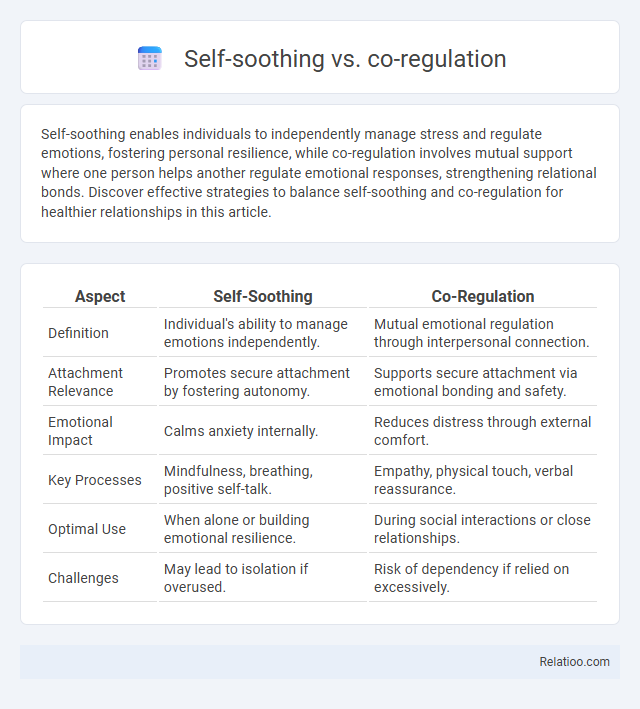Self-soothing enables individuals to independently manage stress and regulate emotions, fostering personal resilience, while co-regulation involves mutual support where one person helps another regulate emotional responses, strengthening relational bonds. Discover effective strategies to balance self-soothing and co-regulation for healthier relationships in this article.
Table of Comparison
| Aspect | Self-Soothing | Co-Regulation |
|---|---|---|
| Definition | Individual's ability to manage emotions independently. | Mutual emotional regulation through interpersonal connection. |
| Attachment Relevance | Promotes secure attachment by fostering autonomy. | Supports secure attachment via emotional bonding and safety. |
| Emotional Impact | Calms anxiety internally. | Reduces distress through external comfort. |
| Key Processes | Mindfulness, breathing, positive self-talk. | Empathy, physical touch, verbal reassurance. |
| Optimal Use | When alone or building emotional resilience. | During social interactions or close relationships. |
| Challenges | May lead to isolation if overused. | Risk of dependency if relied on excessively. |
Introduction to Self-Soothing and Co-Regulation
Self-soothing refers to your ability to independently calm your emotions during stress or distress, often through techniques like deep breathing or mindfulness. Co-regulation involves external support from caregivers or peers to help manage emotional responses, creating a shared calming process. Understanding the distinction between self-soothing and co-regulation is essential for developing effective emotional regulation skills.
Defining Self-Soothing: What Does It Mean?
Self-soothing refers to the ability to calm oneself during moments of distress or emotional overwhelm through internal coping mechanisms such as deep breathing, positive self-talk, or sensory activities like humming or squeezing a stress ball. Co-regulation involves the external support from another person, often a caregiver, who helps manage emotional states by providing comfort, guidance, or physical closeness. Understanding self-soothing as an autonomous skill highlights its role in emotional resilience and independence, whereas co-regulation emphasizes relational and social aspects of emotional regulation.
What is Co-Regulation? Understanding Its Role
Co-regulation is the process where a caregiver or trusted individual helps regulate a child's emotional state through responsive and supportive interaction, providing external calming cues that the child cannot achieve independently. It plays a critical role in early development by fostering a secure attachment and teaching the child how to manage emotions before they develop self-soothing skills. Effective co-regulation gradually leads to increased self-regulation, where the child learns to identify and manage their own emotional responses autonomously.
Key Differences Between Self-Soothing and Co-Regulation
Self-soothing involves Your ability to independently calm and regulate emotional distress through techniques such as deep breathing, mindfulness, or positive self-talk, fostering internal resilience. Co-regulation, in contrast, requires interaction with another person, typically a caregiver or trusted individual, who helps modulate Your emotional state by providing external support, comfort, and validation. The key difference lies in self-soothing's focus on autonomous emotional management, while co-regulation depends on relational dynamics to achieve emotional balance.
The Science Behind Emotional Regulation
Emotional regulation involves complex neural pathways where self-soothing activates the parasympathetic nervous system to reduce stress independently, while co-regulation engages social bonding hormones like oxytocin through interpersonal interactions to modulate emotional responses. Research in developmental neuroscience highlights that co-regulation during early childhood strengthens prefrontal cortex development, enhancing later self-soothing abilities and emotional resilience. Understanding the distinct but complementary roles of self-soothing and co-regulation informs therapeutic approaches that target both autonomic regulation and social context for optimal emotional health.
Benefits of Self-Soothing Strategies
Self-soothing strategies empower individuals to independently manage stress and emotional distress, fostering resilience and enhancing emotional regulation. These techniques, such as deep breathing, mindfulness, and grounding exercises, improve autonomic nervous system balance, reducing cortisol levels and promoting relaxation. Unlike co-regulation, where external support aids emotional calming, self-soothing cultivates personal coping skills crucial for long-term mental health and self-efficacy.
Advantages of Co-Regulation in Relationships
Co-regulation in relationships enhances emotional connection by allowing partners to support each other's regulation of stress and emotions effectively. This dynamic fosters greater empathy, trust, and secure attachment, creating a foundation for healthier interactions compared to self-soothing alone. Your ability to engage in co-regulation promotes resilience and emotional stability, benefiting both individual well-being and the overall relationship quality.
When to Encourage Self-Soothing vs Co-Regulation
Encourage self-soothing in toddlers once they show readiness for independent emotional regulation, such as during bedtime routines to foster autonomy and resilience. Co-regulation is essential during early infancy or moments of heightened distress, providing external support through caregiver presence and calming strategies to help the child modulate emotions. Balancing the transition from co-regulation to self-soothing helps develop emotional intelligence, with caregivers gradually reducing intervention as the child gains coping skills.
Practical Techniques for Self-Soothing and Co-Regulation
Practical techniques for self-soothing include deep breathing, mindfulness meditation, and progressive muscle relaxation, which help you regulate your emotions independently by activating the parasympathetic nervous system. Co-regulation involves using external support, such as a trusted friend or caregiver's calm presence and empathetic communication, to help modulate your emotional state during distress. Combining self-soothing with co-regulation can enhance emotional resilience by fostering both internal coping skills and relational support systems.
Supporting Emotional Development: Building Balance
Self-soothing involves an individual's ability to independently manage and regulate their emotions through calming techniques, fostering internal emotional stability. Co-regulation refers to the interactive process where caregivers provide external support, guiding and modeling emotional regulation until the individual develops self-soothing skills. Supporting emotional development requires balancing self-soothing and co-regulation, ensuring that external guidance gradually transitions to autonomous emotional control while promoting resilience and psychological well-being.

Infographic: Self-soothing vs Co-regulation
 relatioo.com
relatioo.com